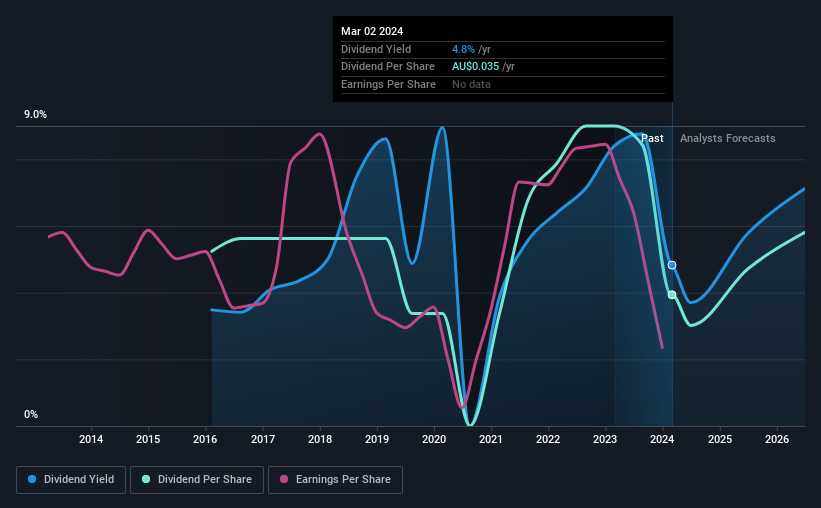Dividend Investors: Don't Be Too Quick To Buy Michael Hill International Limited (ASX:MHJ) For Its Upcoming Dividend
Some investors rely on dividends for growing their wealth, and if you're one of those dividend sleuths, you might be intrigued to know that Michael Hill International Limited (ASX:MHJ) is about to go ex-dividend in just 4 days. The ex-dividend date is one business day before the record date, which is the cut-off date for shareholders to be present on the company's books to be eligible for a dividend payment. The ex-dividend date is important because any transaction on a stock needs to have been settled before the record date in order to be eligible for a dividend. In other words, investors can purchase Michael Hill International's shares before the 7th of March in order to be eligible for the dividend, which will be paid on the 22nd of March.
The company's upcoming dividend is AU$0.0175 a share, following on from the last 12 months, when the company distributed a total of AU$0.035 per share to shareholders. Looking at the last 12 months of distributions, Michael Hill International has a trailing yield of approximately 4.8% on its current stock price of AU$0.725. Dividends are an important source of income to many shareholders, but the health of the business is crucial to maintaining those dividends. So we need to investigate whether Michael Hill International can afford its dividend, and if the dividend could grow.
Check out our latest analysis for Michael Hill International
Dividends are typically paid out of company income, so if a company pays out more than it earned, its dividend is usually at a higher risk of being cut. Michael Hill International distributed an unsustainably high 154% of its profit as dividends to shareholders last year. Without extenuating circumstances, we'd consider the dividend at risk of a cut. Yet cash flows are even more important than profits for assessing a dividend, so we need to see if the company generated enough cash to pay its distribution. Michael Hill International paid out more free cash flow than it generated - 145%, to be precise - last year, which we think is concerningly high. We're curious about why the company paid out more cash than it generated last year, since this can be one of the early signs that a dividend may be unsustainable.
Cash is slightly more important than profit from a dividend perspective, but given Michael Hill International's payouts were not well covered by either earnings or cash flow, we would be concerned about the sustainability of this dividend.
Click here to see the company's payout ratio, plus analyst estimates of its future dividends.
Have Earnings And Dividends Been Growing?
Businesses with shrinking earnings are tricky from a dividend perspective. If business enters a downturn and the dividend is cut, the company could see its value fall precipitously. Michael Hill International's earnings per share have fallen at approximately 16% a year over the previous five years. Such a sharp decline casts doubt on the future sustainability of the dividend.
Another key way to measure a company's dividend prospects is by measuring its historical rate of dividend growth. Michael Hill International has seen its dividend decline 3.5% per annum on average over the past eight years, which is not great to see. It's never nice to see earnings and dividends falling, but at least management has cut the dividend rather than potentially risk the company's health in an attempt to maintain it.
To Sum It Up
Is Michael Hill International an attractive dividend stock, or better left on the shelf? Not only are earnings per share declining, but Michael Hill International is paying out an uncomfortably high percentage of both its earnings and cashflow to shareholders as dividends. This is a starkly negative combination that often suggests a dividend cut could be in the company's near future. It's not an attractive combination from a dividend perspective, and we're inclined to pass on this one for the time being.
So if you're still interested in Michael Hill International despite it's poor dividend qualities, you should be well informed on some of the risks facing this stock. Our analysis shows 2 warning signs for Michael Hill International and you should be aware of these before buying any shares.
If you're in the market for strong dividend payers, we recommend checking our selection of top dividend stocks.
Have feedback on this article? Concerned about the content? Get in touch with us directly. Alternatively, email editorial-team (at) simplywallst.com.
This article by Simply Wall St is general in nature. We provide commentary based on historical data and analyst forecasts only using an unbiased methodology and our articles are not intended to be financial advice. It does not constitute a recommendation to buy or sell any stock, and does not take account of your objectives, or your financial situation. We aim to bring you long-term focused analysis driven by fundamental data. Note that our analysis may not factor in the latest price-sensitive company announcements or qualitative material. Simply Wall St has no position in any stocks mentioned.

 Yahoo Finance
Yahoo Finance 
